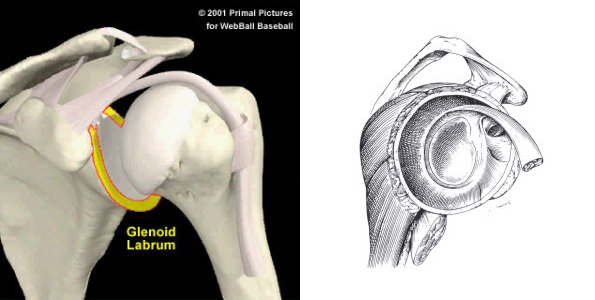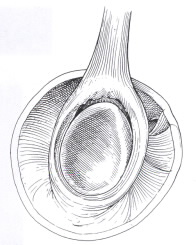LABRUM TEARS/INSTABILITY
The labrum is a ring of fibrocartilage (think firm calamari) that surrounds the glenoid or socket of the shoulder. Its composition is similar to the meniscus in the knee and like it, can tear. We think of the shoulder as a ball and socket joint, but in reality its more like a ball and plate, though.

Left picture shows a normal labrum looking from the fornt. Right picture is viewing the labrum face on with the humerus removed
The glenoid is in reality configured more flat than concave, and it is this feature that allows the shoulder such tremendous range of motion. Think of an oval raceway . The glenoid is the infield and the banked raceway is the labrum The labrum serves several purposes. It’s main function is to increase of contact area for the humeral head (ball). An intact labrum increases the surface area by over 70%. It also contributes to stability of the joint and mediates attachment of the long head of the biceps tendon and ligaments to the glenoid.
The labrum can tear anywhere along its 360 degree arc. Tears superiorly (think 12:00 position on a clock face) are called SLAP tears (Superior Labrum Anterior to Posterior) and involve the biceps attachment. SUPERIOR LABRAL PIC There are multiple types of tear configurations, but most involve detachment of the labrum from the glenoid. This is most commonly occurs after a traumatic event, but can occur from overuse in overhead athletes, such a pitchers and tennis players. The main complaint with labral tears is pain, occasional popping and catching, and sensations of instability. When the shoulder is dislocated, the ligaments and labrum are torn off the glenoid at the 3:00-6:00 position on the clock face. SHOULDER LABRAL REPAIR MEDIUM PIC Because the glenoid is flat, loss of the bumper effect and ligament tension can allow the shoulder to dislocate in the direction of the tear. Anterior dislocations are by far the most common type of dislocation. Once the tissue tears it never heals normally and recurrence is common. With each additional dislocation, there is increased risk of further ligament stretching and bone loss from the socket. If more than 25% of the socket is damaged, the failure rate for arthroscopic repair is 65% and other more invasive procedures are necessary to stabilize the shoulder.
Regardless of the location of the labral tear, most symptomatic athletes will require operative repair of a torn labrum. Many lower demand patients, though, will improve with therapy alone. The best diagnostic test for a labral tear is an examination under anesthesia and an arthroscopic evaluation with probing of the torn tissue. Almost always, though, an MRI is obtained because it is non invasive, uses no radiation, and is quite accurate. There is growing evidence that many MRI diagnosed SLAP tears in patients in their 40’s may not be clinically relevant and excessive stiffness of the shoulder can occur if they are repaired. All SLAP tears and most labral tears are repaired arthroscopically in an ambulatory surgery center. Using guide devices, anchors with sutures attached are inserted into the glenoid rim. The sutures are passed through the labrum and tied. I use the 6 finger device to tie the sutures-it costs a little more, but gives a much more secure knot. A sling is worn for 6 weeks to protect the repair, and physical therapy is started within the first few weeks. Return to contact and racquet sports takes 6 months.



